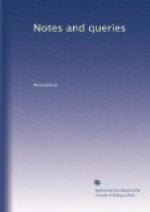“So weak and fallible is that admired maxim, ’Factum valet, quot fieri non debuit,’ an excuse first invented to palliate the unfledged villainy of some men, who are ashamed to be knaves, yet have not the courage to be honest.”
I have not quoted the whole of the passage from Junius, as I consider it to be in almost every body’s hands. I am collecting some curious, and I hope valuable, information about that work.
B.G.
Arabic Numerals.—Your correspondent T.S.D.’s account of a supposed date upon the Church of St. Brelade, Jersey, brings to my mind a circumstance that once occurred to myself, which may, perhaps, be amusing to date-hunters. Some years ago I visited a farm-house in the north of England, whose owner had a taste for collecting curiosities of all sorts. Not the least valuable of his collection was a splendidly carved oak bedstead, which he considered of great antiquity. Its date, plainly marked upon the panels at the bottom of the front posts, was, he told me, 1111. On {359} examining this astounding date a little closely, I soon perceived that the two middle strokes had a slight curvature, a tendency to approach the shape of an S, which distinguished them from the two exterior lines. The date was, in fact, 1551; yet so small was the difference of the figures, that the mistake was really a pardonable one.
Is your correspondent “E.V.” acquainted with the History of Castle Acre Priory, published some years ago? If my memory fails me not, there is a date given in that work, as found inscribed on the plaster of the Priory wall, much more ancient than 1445.
Has the derivation of the first four Arabic numerals, and probably of the ninth, from the ancient Egyptian hieratic and enchorial characters, for the ordinals corresponding with those numbers, ever been noticed by writers upon the history of arithmetical notation? The correspondence will be obvious to any one who refers to the table given in the 4th vol. of Sir G. Wilkinson’s Ancient Egyptians (3rd edit.), p. 198.
C.W.G.
* * * * *
BOOKS AND ODD VOLUMES
WANTED TO PURCHASE.
(IN CONTINUATION OF LISTS IN FORMER NOS.)
McCULLOCH’S ISLES OF SCOTLAND, 4 vols. 8vo. 1824.
ARNOT’S ELEMENTS OF PHYSICS.
LADY MARY FOX—IDEA OF A COUNTRY HOUSE.
ODD VOLUMES.
MAD. DE STAEL—CONSIDERATIONS ON THE
FRENCH REVOLUTION, in 3 vols.
Vol. II.
WORDSWORTH’S POETICAL WORKS, in 4 vols. Vol II.
JAMES’ NAVAL HISTORY, in 4 vols. Vols. II. and III.
YOUNG’S ANNALS OF AGRICULTURE, Fortieth and Five remaining volumes.
* * * * *
NOTICES TO CORRESPONDENTS.
We are compelled to omit our usual Notes on Books, &c., as well as many interesting communications.




